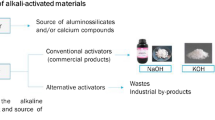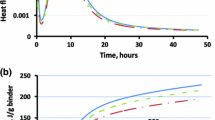Abstract
From technical, economic and ecological points of view, siliceous by-products are now recognized and accepted as desirable and vital constituents of concrete. Current specifications for such materials tend to be restrictive to some extent, however, and in many countries there are separate standards for each admixture. These in turn inhibit the wider use of these mineral additions to concrete. This paper presents a review of the more important aspects of current standards for siliceous admixtures in this context. It is shown that there is not only a lack of uniformity in the requirements of these standards, but also wide variations in the limits set for a given requirement. It is suggested that these variations reflect not only the industrial or agricultural background of the by-products but also the inevitable wide range of compositions arising from it. The paper discusses selected items of specifications such as alkali contents, the role of physical properties and mineralogical compositions in the development of strength, the relationship of composition to hydraulicity and the relevance of the pozzolanic and slag activity index tests. Guidance is given on the development of a reliable slag activity index test related to its performance in concrete. An accelerated test is also recommended as an acceptance criterion. The integrity and durability of concrete structures is closely linked with the characteristics of the materials used, but there is no clear understanding of this interrelationship with design and construction. Under these circumstances, material specifications are likely to be prescriptive and sometimes restrictive. The need, however, to correlate requirements for quality control and quality assurance with the real performance of the concrete in the structure cannot be overemphasized. The paper proposes a more positive and engineering-oriented approach to the use of these materials in concrete, so that a wider range of the applications of concrete in practice can incorporate these mineral admixtures as partial cement replacements.
Resume
D'un point de vue technique, économique et écologique, les sous-produits siliceux sont maintenant reconnus et acceptés comme des constitutants souhaitables, voire indispensables, du béton. Cependant, les spécifications en vigueur pour ces matériaux tendent, dans une certaine mesure, à être restrictives, et, dans de nombreux pays, il existe des normes séparées pour chaque catégorie d'addition minérale et d'adjuvant. L'ensemble de ces normes freine une utilisation plus large de ces produits.
Cet article recense les aspects les plus importants des normes en vigueur pour les additions siliceuses dans ce contexte. On montre que les spécifications de ces normes manquent d'unité, mais qu'on trouve aussi une grande diversité dans les limites assignées à une spécification donnée. On suggère que ces variations reflètent non seulement l'arrière-plan lié à l'industrie et à l'agriculture de ces sous-produits, mais également l'inévitable diversité de composition qui en résulte.
On discute ici des points particuliers tels que les teneurs en alcali, le rôle des propriétés physique et des compositions minéralogiques dans le développement de la recherche, la relation entre la composition et l'hydraulicité, ainsi que la pertinence des essais de l'indice d'activité des pouzzolanes et des laitiers. On donne des indications pour l'élaboration d'un essai fiable de l'indice d'activité des laitiers par rapport à leur performance dans le béton. On recommande aussi un essai accéléré comme critère de réception.
L'intégrité et la durabilité des structures en béton sont étroitement liées aux caractéristiques des matériaux utilisés, mais on n'a pas une compréhension claire de cette interrelation par rapport aux règles de conception et de réalisation des ouvrages. Dans ces conditions, les spécifications relatives au matériau risquent d'être prescriptives et parfois restrictives. Cependant, on ne peut trop souligner la nécessité d'établir une corrélation entre les exigences du contrôle et de l'assurance de qualité et la performance réelle du béton dans la structure. Cet article propose une approche plus positive et mieux orientée ver le génie civil de l'utilisation de ces matériaux dans le béton, en sorte qu'un plus large éventail d'applications du béton dans la pratique puisse incorporer ces additions minérales comme remplaçants partiels du béton.
Similar content being viewed by others
References
Mehta, P. K., ‘Standard specifications for mineral admixtures-an overview’, in ACI Publication SP-91, Vol. 1 (1986), pp. 637–658.
RILEM Technical Committee 73-SBC, ‘Siliceous byproducts for use in concrete’, Final Report,Mater. Struct. (1988).
Mehta, P. K., ‘Effect of fly ash composition on sulphate resistance of cement’,ACI J. (1983).
Hooton, R. D., ‘Properties of a high alkali lignite fly ash in concrete’, in ACI Publications SP-91, Vol. 1 (1986). pp. 333–345.
Demoulian, E., Gourdin, P., Hawthorn, F. and Vernet, C., ‘Influence of slags chemical composition and texture on their hydraulicity’, in Proceedings of 7th International Congress on the Chemistry of Cement, Paris, 1980, Vol. 2 III.
Cabrera, J. G., Hopkins, C. J., Wooley, G. R., Lee, R. E., Shaw, J., Plowman, C. and Fox, H., ‘Evaluation of the properties of British pulverized fuel ashes and their influence of the strength of concrete’, in ACI Publication SP-91, Vol. 1 (1986) pp. 115–144.
CAN/CSA-A 23.4-M86, ‘Supplementary cementing materials’ (Canadian Standards Association 1986).
Swamy, R. N. and Anand, K. L., ‘Behaviour of high alumina cement concrete under sustained loading’Proc. Inst. Civil Engs. Part 2 57 (1974) 651–671.
Swamy, R. N., ‘Alkali-silica reaction and concrete structures’,Struct. Engng Rev. (1990) 89–103.
CEMBUREAU, ‘Cement Standards of the World’ (European Cement Association, 1985).
Draft Report, ‘The Use of GGBS and PFA in Concrete’ (Concrete Society, London, 1988).
BS 8110∶1985, ‘The Structural Use of Concrete’ (British Standards Institution, London, 1985).
BS 5328∶1981, ‘Methods ofr Specifying Concrete Including Ready-Mixed Concrete’ (British Standards Institution, London, 1981).
Swamy, R. N. and Al-Asali, M. M., ‘Expansion of concrete due to alkali-silica reaction’,ACI Mater. J. 85, (1) (1988) 367–374.
Idem Swamy, R. N. and Al-Asali, M. M., ‘Engineering implications of ASR expansion in concrete and the effectiveness of mineral admixtures’, (DI: 1988 Swedish Council for Building Research, 1988) pp. 133–155.
Working Party Report, ‘Alkali-silica reaction: minimising the risk of damage to concrete’ (Concrete Society, 1987).
Locher, F. W., ‘The German regulations of low alkali cement’, in Proceedings of 4th International Conference on Effects of Alkalis in Cement and Concrete, Purdue University, June 1978, pp. 215–228.
Lewis, D. W., ‘ASTM standards for ground granulated blast-furnace slag’ in Proceedings of International Workshop on Granulated Blast-Furnance Slag in Concrete, Canada, 1987, pp. 275–285.
Hogan, F. J. and Rose, J. H., ‘ASTM specification for ground iron blast-furnace slag: its development, use and future’, in ACI Publication SP-91, Vol. 2 (1986) pp. 1551–1576.
Rossouw, E. and Kruger, J., ‘Review of specifications for additions for use in concrete’, in ACI Publication SP-79, Vol. 1 (1983), pp. 201–220.
Hooton, R. D., and Emery, J. J., ‘Glass content determination and strength development predictions for vitrified blast-furnace slag’, in ACI Publication SP-79, Vol. 2 (1983) pp. 943–962.
Author information
Authors and Affiliations
Rights and permissions
About this article
Cite this article
Swamy, R.N. Fly ash and slag: standards and specifications—help or hindrance?. Materials and Structures 26, 600–613 (1993). https://doi.org/10.1007/BF02472835
Issue Date:
DOI: https://doi.org/10.1007/BF02472835




